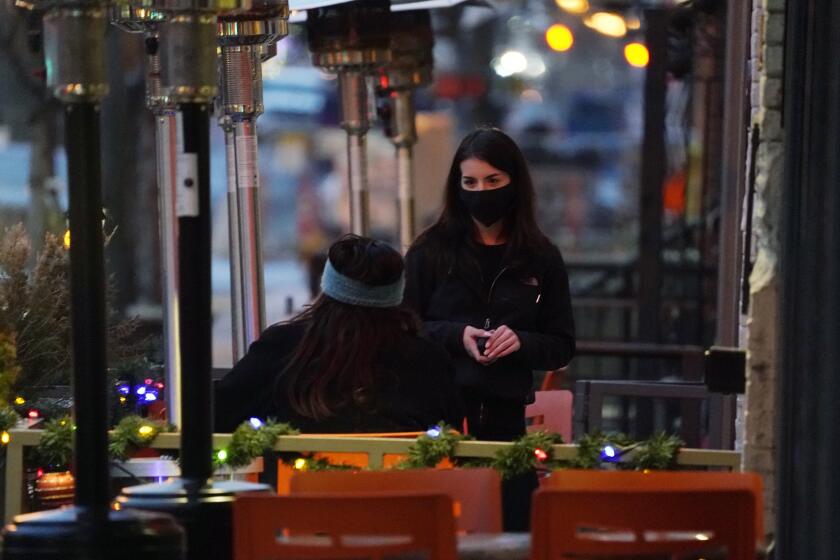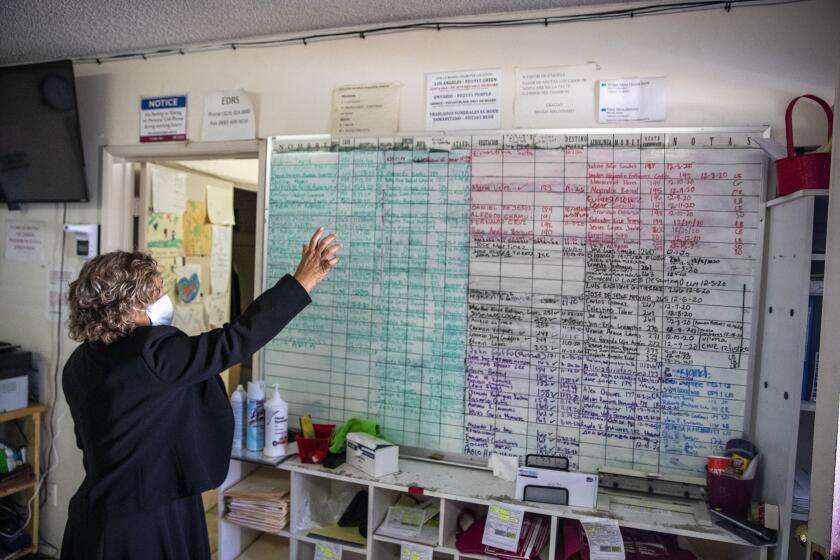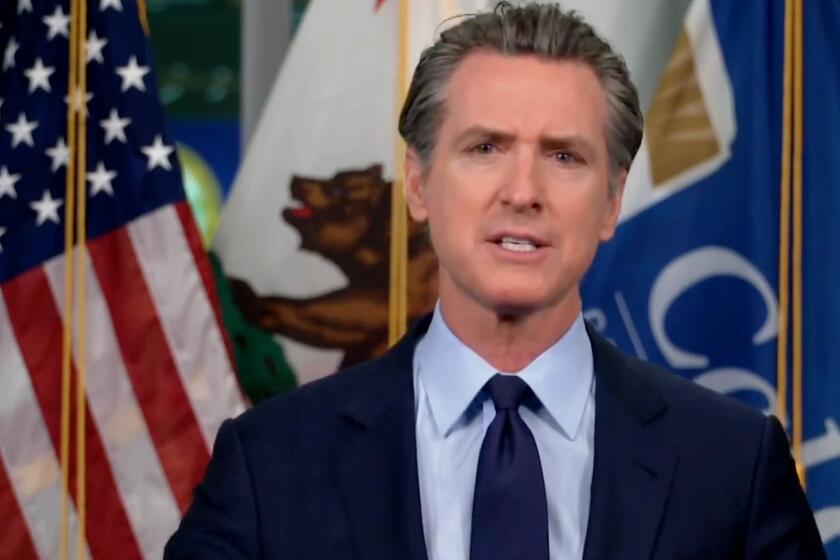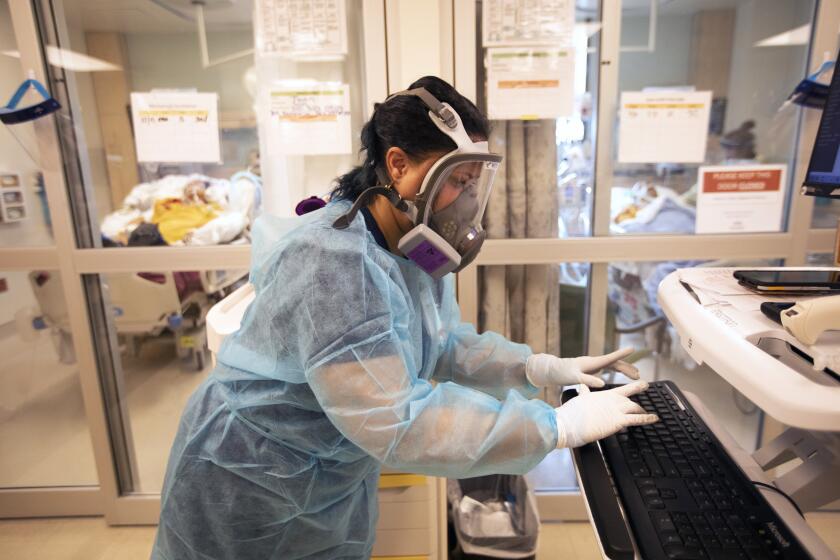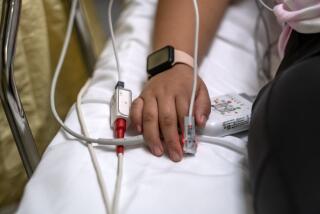New, potentially more contagious coronavirus variant found in California, Newsom says
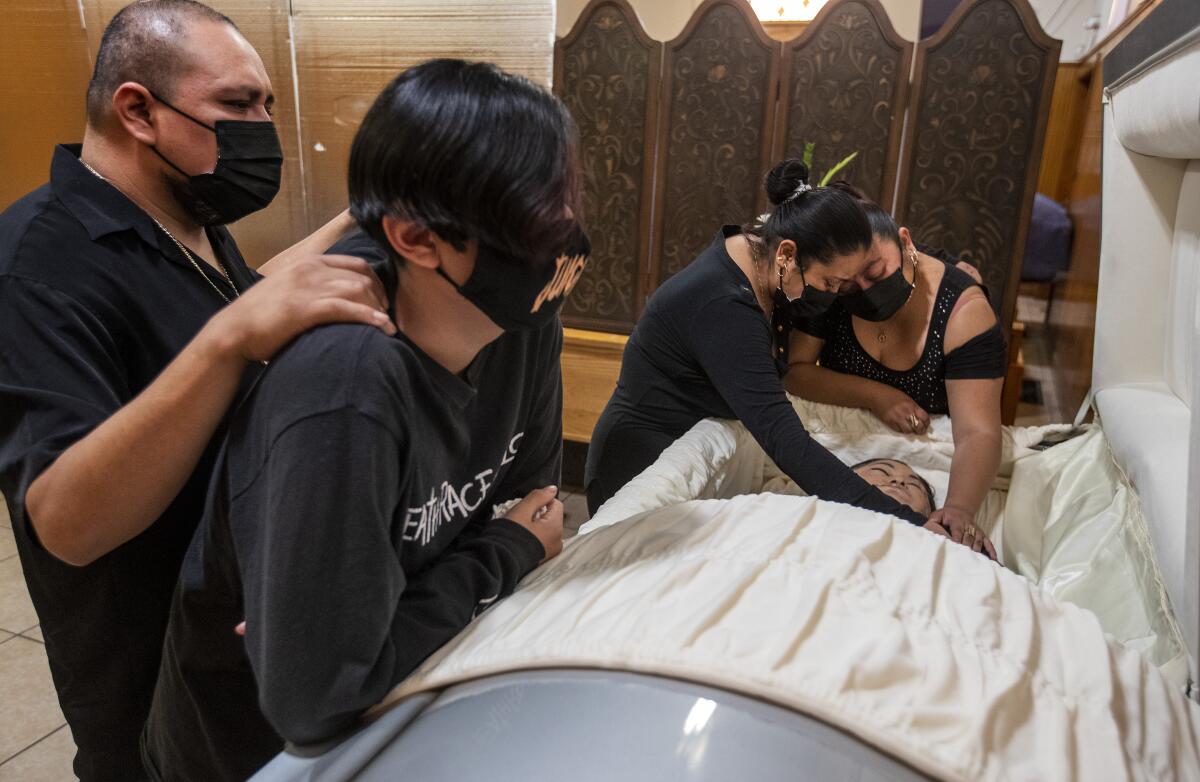
- Share via
The new, potentially more contagious variant of the coronavirus first identified in the United Kingdom has been found in California, Gov. Gavin Newsom said Wednesday.
He did not specify where in the state the variant was identified, but San Diego County officials announced later in the day that they had confirmed the strain in a 30-year-old man who tested positive there after developing symptoms Sunday.
Officials said the man had “no travel history.” As a result, “we believe this is not an isolated case in San Diego County,” Supervisor Nathan Fletcher said during a press conference.
“While it’s been pointed out that there is not yet evidence that the strain has any more severe symptoms, there is significant evidence that it does spread considerably faster, that it is much more contagious,” he said.
That’s all the more reason why county officials “continue to encourage the public and plead with the public to please come together, especially over the next 72 hours and the New Year’s holiday, to please follow the public health order,” Fletcher added.
The first reported U.S. case of COVID-19 caused by the variant was detected in Colorado, officials there announced Tuesday.
The coronavirus variant is found in a man in his 20s who is in isolation southeast of Denver and has no travel history, state health officials say.
Newsom disclosed the recent finding during a virtual conversation with Dr. Anthony Fauci, the nation’s top infectious-disease official — who said he was not surprised by the development, given the strain’s prevalence in the United Kingdom and how common travel is between there and the United States.
“I don’t think that Californians should feel that this is something odd,” he said. “This is something that’s expected.”
Mutations in the coronavirus are also not unanticipated, Fauci said, since “the more you replicate, the more you mutate. So, when you have a lot of virus that’s circulating in the community, it means it’s infecting a lot of people; it’s replicating a lot.”
The “overwhelming majority of mutations are irrelevant,” he continued, but “every once in a while, you get a mutation that does impact a function of the virus.”
“It appears, from what we’ve learned from the U.K. and what we’ll prove here, that this particular mutation does in fact make the virus better at transmitting from one person to another,” he said.
Southern California mortuary and funeral home operators say they are having to turn away bereaved families because they can’t handle more bodies.
Some scientists, however, are more skeptical that genetic changes in the strain, known as B.1.1.7, make it more contagious. There are other possible explanations for the variant’s rapid spread in England, such as its transmission through dense communities and among people who are less likely to wear masks and socially distance.
Either way, “there’s no indication at all that it increases the virulence … the ability to make you sick or kill you,” Fauci said of the variant, adding that it appears existing vaccines also remain effective.
Officials have yet to find any evidence of the variant in Los Angeles County, which the coronavirus is already hitting particularly hard, according to Public Health Director Barbara Ferrer.
“This doesn’t mean that the variant is not circulating in L.A. County,” she cautioned during a briefing Wednesday. “We have thousands and thousands of people getting tested every day, and we are just able to sample a small number of those test results and do the gene sequencing.”
Whether the variant is present or not, she added, “doesn’t change the need for all of us to use the strategies that we have available right now to limit exposure and spread of the virus.”
The announcement came as California reached another sobering milestone in the COVID-19 pandemic, recording 25,000 deaths from the disease as it continues to run rampant through the state.
The toll, confirmed through a Times county-by-county tally of local health jurisdictions, includes a new single-day record set Tuesday, when the state logged 442 fatalities: equivalent to someone dying of the disease every three minutes.
Newsom called the recent death figure “very, very sobering” and said he hopes it underscores “the importance of being safe and using common sense,” particularly with New Year’s Eve right around the corner.
“We look forward to turning the proverbial page on 2020, at least many of us do, and I hope we all do it safely as we celebrate the end of this very long, arduous year,” he said during a briefing Wednesday.
California students in kindergarten through second grade would be allowed back on campus when pandemic conditions improved under a proposal announced Wednesday.
More than half of the deaths reported Tuesday — 242 — were of Los Angeles County residents, according to The Times’ survey. That’s a single-day record for the nation’s most populous county, though the count was boosted in part by a backlog of reports from the Christmas weekend.
At that rate, cumulative COVID-19 deaths will likely exceed 10,000 in L.A. County by New Year’s Day. As of Tuesday night, L.A. County had 9,806 cumulative deaths.
Over the last week, the state averaged 240 deaths a day and L.A. County 111.
“Suffering followed by more suffering continues as too many residents and businesses behave as if we are not living in the most dangerous time of the most devastating pandemic,” Ferrer said in a statement. “Our healthcare workers are overwhelmed with COVID-19 patients and this current path of surging COVID-19 hospitalizations is not sustainable.”
The climbing death toll has changed daily life throughout Los Angeles. In East L.A., the Continental Funeral Home has seen its typical caseload more than quadruple, with 80% of its services honoring people who died from COVID-19. The L.A. County College of Nursing and Allied Health is postponing the admission of nursing students for the spring semester because faculty and staff have been redeployed to county hospitals.
The “healthcare situation has never been this critical and the need for healthcare workers is at its peak,” Mildred Gonzales, dean and program director of the college’s School of Nursing, wrote in a letter, calling the current time an “unprecedented critical situation.”
With intensive care units across California overcrowded, healthcare providers have already been forced to take steps limiting how much hospital care is given.
Southern California hospitals in crisis
“We certainly know that Southern California hospitals are in crisis,” said Dr. Mark Ghaly, the California health and human services secretary.
And with some people likely to ignore pleas to stay home for New Year’s Eve, officials expect hospitalizations to increase again in the coming weeks, particularly during mid- to late January.
“The next number of weeks will be challenging, in particular as it relates to this surge on top of a surge — I would argue on top, again, of a likely additional surge coming from Christmas and, hopefully, one that’s a little more modest from New Year’s,” Newsom said.
Ferrer urged all Angelenos to eschew hosting or attending in-person parties with other households for the coming holiday.
“Make ending this deadly surge part of your New Year’s resolution,” she said.
Even now, paramedics and emergency medical technicians are declining to transport some less severely ill patients whom they might take to the hospital under ordinary circumstances.
In Los Angeles County, EMTs “are assessing patients and releasing them to stay at home, because they aren’t quite sick enough to need hospital-level care. ... If they did come to the hospital, they may not get the type of attention that they might expect,” Ghaly said.
That’s an example of the unusual measures healthcare personnel have been forced to take amid a systemwide overcrowding of hospitals not seen in modern California history, a result of the worst pandemic in more than a century. For the first time, the number of people hospitalized for COVID-19 statewide has exceeded 20,000, a figure eight times higher than that on Nov. 1.
The overcrowding is already causing the quality of healthcare to suffer, Ghaly said.
A plan to triage and ration hospital care
State officials have yet to hear reports of the most dire circumstances, such as a hospital having to choose who gets the last available ventilator.
Nonetheless, some hospitals in L.A. County are running dangerously low on supplies of oxygen, treating patients in conference rooms and gift shops, and leaving patients waiting in ambulances for as long as eight hours until they can be taken into the emergency room.
Hospital systems are already coming up with triage plans, which entail prioritizing the time of highly trained staff — such as respiratory therapists, ICU nurses and critical care doctors — in a way to keep as many people alive as possible. That means that those less likely to survive might not receive the same level of care they would have otherwise.
Most hospitals in California are no longer able to offer regular hospital services, switching instead to “contingency care,” Ghaly said, in which staff are asked to work longer shifts, hospital rooms are reconfigured to hold more beds than originally intended, scarce supplies are conserved or even reused and the movement of patients within the hospital is delayed because of a lack of space or staff.
Hospitals in lower-income, densely populated and nonwhite communities face the greatest challenge in providing care, a Times data analysis finds.
Preparing for ‘crisis care’
Even graver is “crisis care,” when people are placed on cots instead of standard hospital beds; patients normally grouped in one unit are scattered across the facility; and certain supplies, therapies and staff need to be rationed, Ghaly said.
If some hospitals in a region declare that they’re in “crisis care” mode, other hospitals in the region will be asked to share their resources to relieve the worst-hit facilities, Ghaly said.
Kim McCoy Wade, director of the California Department of Aging, said Tuesday that tough decisions on how to allocate medical care must be “grounded in the likelihood of [a patient] surviving in the near term.” Such decisions cannot be based on age, race, disability, chronic medical conditions, gender, sexual orientation, gender identity, ethnicity, national origin, language spoken, ability to pay, weight, socioeconomic status, insurance status, perceived self-worth, perceived quality of life, immigration status, incarceration status, homelessness or past or future use of resources, she said.
The state Department of Public Health on Monday issued a memo about its “California Crisis Care Continuum Guidelines,” which, they said, must follow ethical principles, health equity goals and civil rights laws. Facilities that need to begin to ration critical care resources must notify local and state public health departments immediately.
Choosing who gets care
According to a state memo issued in June, in a situation where there’s a severe shortage of medical resources and a patient has a poor immediate survival prognosis, healthcare providers may opt for palliative care aimed at providing patients relief from pain as they approach death.
When it comes to deciding who is eligible for ICU admission or should have access to a ventilator, patients who are more likely to survive with such care will receive priority.
A hospital-appointed triage officer is expected to make decisions to benefit populations of patients, “even though these decisions may not necessarily be best for some individual patients,” according to the memo.
Health officials battling fatalism and denial
Hospitals and health officials throughout the state are reporting severe problems. In the agricultural community of Gilroy in Santa Clara County, every regular ICU bed at St. Louise Regional Hospital is occupied, and patients are now in overflow beds, said Gloria de la Merced, the hospital’s chief operating officer.
“This level of hospitalizations has never happened during my career,” she said. “If we go beyond the surge capacity, everyone will be affected — more people in our community will know someone who died.”
In Fresno County, emergency rooms are so crowded that paramedics are dropping off patients in hospital hallways, where they’re cared for by other emergency workers, or in the waiting room. Officials are battling a sense of fatalism in the general public that nothing can be done about the pandemic or denial about the record hospitalizations and death toll.
“That’s really unfortunate. … We really do have a choice, and we really can try to protect ourselves in our communities with the choices that we make,” such as wearing masks and canceling New Year’s parties, said Dr. Rais Vohra, the Fresno County interim health officer. “Whenever you choose to ignore the science, that’s when we really get into trouble.”
In rural Northern California, Humboldt County became the first county in some time to see conditions improve enough that it was moved from the state’s most restrictive purple tier to a less restrictive red tier, enabling it to reopen indoor restaurant dining, indoor gyms and movie theaters, although at a limited capacity.
Local health officials, however, criticized the state for moving Humboldt into a less restrictive tier, saying that ongoing trends suggest the county could fall backward in the coming days.
“Our case rates are the highest they’ve ever been, and our contact investigation teams are tracking more cases, not fewer. It’s unfortunate that we didn’t get to have a conversation with the state before this decision was handed down,” the Humboldt County health officer, Dr. Ian Hoffman, said in a statement Tuesday.
Times staff writers Emily Baumgaertner, Andrew J. Campa, Andrea Castillo, Jaclyn Cosgrove, Adam Elmahrek, Marisa Gerber, Soumya Karlamangla and Ryan Murphy contributed to this report.
More to Read
Sign up for Essential California
The most important California stories and recommendations in your inbox every morning.
You may occasionally receive promotional content from the Los Angeles Times.
